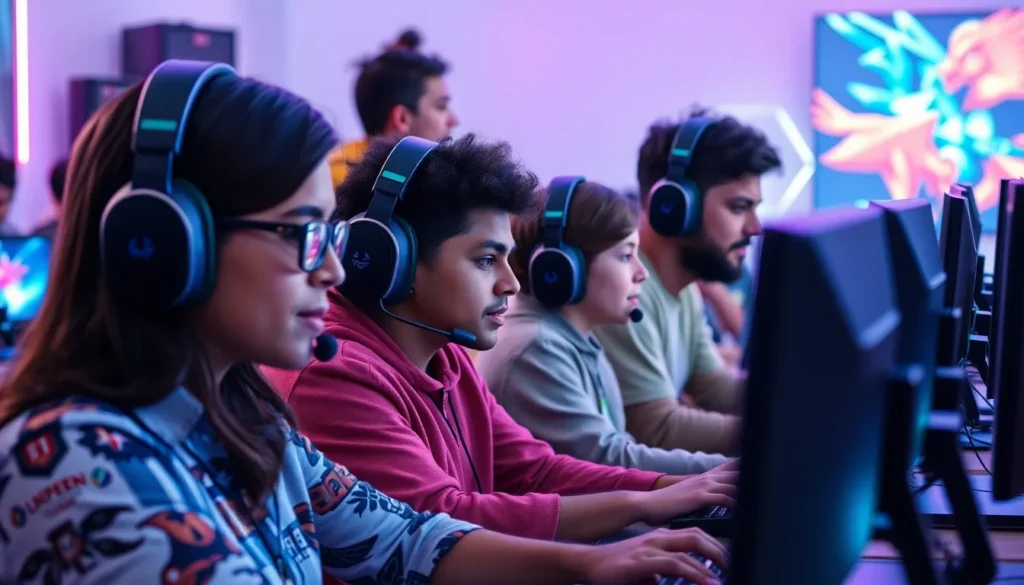In a world where games can transport players to fantastical realms or challenge their wits, Python game development stands out as the secret sauce for aspiring developers. With its simple syntax and powerful libraries, Python makes game creation feel less like rocket science and more like a fun puzzle waiting to be solved. Who knew coding could be this exciting?
Overview of Python Game Development
Python game development offers an approachable entry point for new developers. The language boasts a simple syntax that eases the learning curve. Powerful libraries enhance its capabilities, facilitating the creation of complex games. Libraries such as Pygame and Panda3D provide essential tools for developing 2D and 3D games, respectively.
Using Python, developers can focus on creativity without extensive coding requirements. Game mechanics like physics interactions and character movements become straightforward to implement. The community surrounding Python is vast and supportive, contributing numerous resources and tutorials that bolster learning experiences.
Game development in Python has gained popularity, allowing developers to create engaging games ranging from casual puzzles to more elaborate role-playing experiences. Developers can integrate multimedia elements seamlessly, including graphics and sound effects, enhancing user engagement.
Collaborative projects thrive within the Python ecosystem. Teams often share code and knowledge, spurring innovation and improving game quality. This collaboration fosters a sense of community among developers, boosting motivation and skill development.
Adapting existing games or building entirely new ones is common within this framework. Developers can leverage the flexibility of Python to create unique gameplay experiences that cater to diverse audiences. With continuous improvements to the language and its libraries, Python game development remains dynamic, inviting new talents to explore and experiment.
Benefits of Using Python for Game Development

Python offers several advantages that make it an ideal choice for game development, providing both accessibility and creative potential for developers.
Easy to Learn and Use
Developers appreciate Python for its straightforward syntax, which reduces the learning curve. Clarity in code helps programmers grasp concepts quickly, allowing them to focus on design and gameplay rather than complex syntax rules. New developers find that they can create functional prototypes faster compared to languages with steeper learning curves. Also, the interactive nature of Python’s environment engages developers, making the coding process feel intuitive and enjoyable. Its readability fosters collaboration, enabling teams to communicate effectively and share code seamlessly. Overall, Python’s ease of learning supports aspiring developers on their journey in game development.
Extensive Libraries and Frameworks
Python boasts an impressive array of libraries and frameworks that extend its functionality. Pygame serves as a popular choice for 2D game creation, providing essential tools for graphics and sound. For those interested in 3D games, Panda3D opens up opportunities for rich gameplay experiences. Other libraries, like Arcade and Godot, offer additional features tailored to specific game development needs. Community contributions enhance these libraries, supplying ample resources and tutorials for developers at all levels. The vast collection of libraries accelerates the development process, allowing developers to focus on creativity and innovation in their gaming projects.
Popular Python Game Development Libraries
Python offers several libraries that significantly enhance game development, catering to various needs and preferences. Key libraries include Pygame, Panda3D, and Godot Engine.
Pygame
Pygame remains one of the most popular libraries for creating 2D games in Python. This library includes modules for handling graphics, sound, and input devices, making game development accessible. Developers appreciate its simplicity and extensive documentation, which provides clear guidance for new users. Many indie developers use Pygame for rapid prototyping due to its lightweight nature and straightforward API. Sample games demonstrate Pygame’s capabilities, ranging from platformers to arcade-style games. With an active community, Pygame offers numerous tutorials, resources, and forums for support.
Panda3D
Panda3D excels in creating 3D games using Python. This engine supports advanced graphics and physics features, allowing developers to create visually stunning experiences. It integrates with popular Python libraries, enhancing flexibility in development. Developers value its scene graph architecture, which simplifies rendering complex scenes. Additionally, Panda3D provides tools for asset management and real-time rendering, making it suitable for both small and large projects. Resources, such as documentation and community forums, are readily available, promoting collaboration and knowledge sharing among developers.
Godot Engine
Godot Engine stands out as a versatile game engine with support for both 2D and 3D games. Its user-friendly interface and visual scripting tools appeal to beginners and experienced developers alike. Godot’s scene system encourages modular design, allowing easy management of game elements. Python developers can use GDScript, which shares similarities with Python, easing the learning curve. An active community provides ample resources, including tutorials and plugins, enhancing the development process. Godot’s versatility and accessibility make it a popular choice for many game developers.
Getting Started with Python Game Development
Python game development presents an exciting opportunity for new programmers to dive into creative projects. Developers can quickly realize their game ideas using Python libraries.
Setting Up the Development Environment
First, choose an appropriate Integrated Development Environment (IDE). Popular options include PyCharm and Visual Studio Code, which offer robust features to enhance coding efficiency. Next, install Python from the official website to ensure access to the latest version. After that, utilize a package manager like pip to install essential libraries, including Pygame or Panda3D. Setting up a virtual environment helps manage project dependencies efficiently. Ensure that all components are properly configured to streamline the development process.
Creating Your First Game
Starting small is key in game development. Developers often begin by creating a simple game like a classic “Pong” or “Snake.” Following this, one can use Pygame to create a window and manage game events and graphics. Coding the main loop is crucial for handling user input and updating the game state. Adding visuals, like sprites and backgrounds, enhances the game’s appeal. Testing frequently during development provides valuable feedback. Gradually, additional features such as sound effects and scoring systems can be implemented to enrich the gameplay experience.
Best Practices for Python Game Development
Effective game development with Python requires attention to several best practices that enhance both organization and efficiency. Developers benefit from adopting a few key strategies.
Code Organization
Organizing code improves readability and maintainability. Utilize folders to separate assets, scripts, and resources. Group related functions and classes into modules, which simplifies navigation. Clear naming conventions for functions and variables create an intuitive understanding of their purpose. Comments effectively explain complex logic and enhance collaboration among team members. Employing design patterns, such as Model-View-Controller, structures code and optimizes workflow. These practices lead to faster debugging and easier updates.
Performance Optimization
Optimizing game performance ensures smooth gameplay experiences. Identify bottlenecks by profiling code and analyzing resource usage. Utilize efficient algorithms to reduce computational load. Limit the use of global variables, as they can slow down performance and complicate debugging. Assets often require compression to minimize loading times. Prioritize rendering techniques to enhance visual fidelity while maintaining frame rates. Implementing object pooling manages resource allocation efficiently, reducing memory overhead. By prioritizing these strategies, developers create engaging and responsive games.
Conclusion
Python game development offers a unique blend of accessibility and creativity that appeals to both new and experienced developers. Its simple syntax and powerful libraries empower creators to focus on their imaginative ideas while minimizing technical barriers. With robust tools like Pygame and Panda3D, developers can easily bring their visions to life, whether they’re crafting engaging 2D puzzles or immersive 3D worlds.
The supportive community surrounding Python further enhances the development experience. By sharing resources and knowledge, developers can continuously improve their skills and innovate within the gaming landscape. Embracing Python for game development not only fosters creativity but also opens doors to endless possibilities in the gaming realm.



